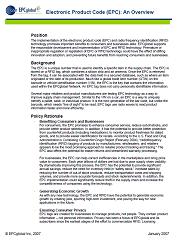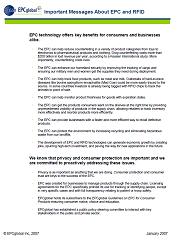
EPCglobal®
EPCglobal® is leading the development of industry-driven standards for the Electronic Product Code™ (EPC) to support the use of Radio Frequency Identification (RFID) in today's fast-moving, information rich, trading networks. Our goal is increased visibility and efficiency throughout the supply chain and higher quality information flow between companies and their key trading partners.
Find out more about EPCglobal >>
Background Information
The EPC is a unique number that is used to identify a specific item in the supply chain. The EPC is stored on a RFID tag, which combines a silicon chip and an antenna. Once the EPC is retrieved from the tag, it can be associated with the data held in a secured database, such as where an item originated or the date of its production. Much like a global trade item number (GTIN) on the barcode or vehicle identification number (VIN), the EPC is the key that contains the information used within the EPCglobal Network. An EPC tag does not carry personally identifiable information.
Several major retailers and product manufacturers are testing EPC technology as a way to improve supply chain management. Similar to the VIN on a car, an EPC is a way to uniquely identify a pallet, case, or individual product. It is the next generation of the bar code, but unlike the barcode, which needs “line of sight” to be read, EPC tags use radio waves to read product information faster and more efficiently.
Overview of EPC
 |
Business and Consumers Benefits
 |
Frequent Asked Questions (FAQs)
- What is an Electronic Product Code?
Electronic Product Code, or EPC, is a unique identification code that is generally thought of as the next generation of the standard bar code. Like the bar code, EPC uses a numerical system for product identification, but its capabilities are much greater. An EPC is actually a number that can be associated with specific product information, such as date of manufacture, origin and destination of shipment. This provides significant advantages for businesses and consumers. EPCs do not carry personally identifiable information.
- How does EPC work?
The EPC is stored on a Radio Frequency Identification (RFID) tag, which transmits data when prompted by a signal emitted by a special reader. EPC and RFID are not interchangeable. The EPC is a supply chain application that maximizes RFID technology to provide a level of visibility never before possible. There are numerous RFID applications that have nothing to do with the EPC, such as E-Z Pass use at tollbooths.
- What’s in it for consumers?
The EPC has the potential to help us all. It could help businesses improve supply chain efficiencies and visibility, which would benefit consumers through improved product availability, speed of service, and quality assurance. It could help prevent counterfeit goods from reaching consumers by tracking their products from its source and enhance manufacturers’ ability to quickly and effectively recall damaged or defective products. The EPC has the potential to allow retailers to track inventory more effectively, reorder products more efficiently and get the products consumers want on the shelves at the right time.
- What’s in it for businesses?
The EPC can help businesses transform their processes in order to improve their own efficiency while providing additional consumer benefits. Poor supply chain visibility results in more than $81 billion annually in losses to U.S. businesses due to lost, stolen, and out-of-stock inventory. The technology behind EPC can help businesses track inventory more effectively, reorder products more efficiently and reduce the number of times a product is “out of stock.”
In addition, the EPC may also help companies track their shipments to prevent tampering and to prevent counterfeit or illicit goods from entering the marketplace. For instance, the U.S. Food and Drug Administration estimate that 7 percent of pharmaceutical worldwide are counterfeit. EPC can change all of this because of its ability to track specific items from manufacture to destination. Items will be routed properly, and those with fake or duplicate tags can be investigated and removed quickly and easily.
- How were RFID and EPC developed?
RFID has been around for a long time and is used every day by consumers for systems like E-Z Pass, which speeds commuters through toll booths, and for SpeedPass electronic payments at Exxon and Mobil stations. To combat Mad Cow disease, European nations and Canada are using RFID to track livestock. In fact, it was first developed by the allies in World War II to identify friendly aircraft in battle.
EPC was developed much more recently by researchers at the Massachusetts Institute of Technology’s Auto-ID Center trying to help businesses identify items in the supply chain, automatically and in real time. Before EPC could be implemented in the real world, it required an international standard.
- Who is creating standards and managing implementation of EPC?
EPCglobal Inc was created a joint venture between GS1 (formerly EAN International) and GS1 US (formerly the Uniform Code Council, Inc.) — the same organizations entrusted to drive adoption of the barcode — to develop standards and to create a “visible” global supply chain. EPCglobal is a neutral, not-for-profit standards organization consisting of manufacturers, technology solution providers, and retailers. Many industries participate in the EPCglobal standards development process such as aerospace, apparel, chemical, consumer electronics, consumer goods, healthcare & life sciences and transportation & logistics.
- What about consumer privacy concerns?
EPC tags are created for businesses to manage products, not people. An EPC tag contains no personally identifiable information. EPCglobal and its community of subscribers recognize that, for EPC to gain broad public acceptance, consumers must have confidence in its value and benefits and in the integrity of its use. EPC participants are committed to gaining and retaining this public confidence. Privacy has been a focus of the EPC developers and subscribers since the earliest stages of the effort to commercialize RFID for supply chain issues.
EPCglobal has created a multi-industry, global Public Policy Steering Committee to anticipate and engage in policy issues and address them through education and outreach to key stakeholders in the public and private sectors. EPCglobal subscribers have developed self-regulating guidelines that can evolve as the technology develops. The EPCglobal Guidelines on EPC for Consumer Products promote consumer notice, education, and choice about the technology and include consumer privacy protections. Licensing agreements for the EPC specifically prohibit its use for tracking or identifying people, except in very specific, transparent patient and troop safety applications. More information can be found at https://www.gs1.org/epcglobal/public_policy.
EPC tags only transmit product data when prompted by a signal emitted by a special reader with access to a secure database. Readability is often unreliable beyond 10 feet in an optimal warehouse setting and, for some tags, the proximity for readers is measured in inches. Without access to the secure database, any code retrieved is meaningless.
Consumers will be informed of the choices that are available to discard or remove, or in the future disable, the EPC tags from the products they acquire. Consumers may sometimes wish to keep the tags for ease of product returns, recalls, and recovery of stolen goods. The technology is still in its infancy but, as new developments in the EPC and its deployment occur, the EPCglobal Guidelines on EPC for Consumer Products will evolve, while continuing to represent the fundamental commitments of industry to consumers. It is hoped that further developments, including advances in technology, new applications, and enhanced post-purchase benefits, will provide even more choices to both consumers and companies on the use of EPC tags.
- What kind of consumer input has there been?
The research and development process has been open and transparent. Starting with the Auto-ID Center and carrying over to EPCglobal, there has been extensive input from consumers, industry, community leaders, and others to understand and address concerns. EPCglobal has participated in open forums on RFID, testified before legislative committees and governmental associations, and is reaching out to influential consumer groups and other interested associations such as the National Consumers League and the Center for Democracy and Technology.
- When can we expect to see item-level tagging?
Widespread item-level tagging is far off. Today, the focus is on pallet and case-level tracking. Widespread item-level tagging will be driven not only by adoption of and advances in the technology, but also by demand and need. For example, item-level tracking may be driven by the desire to protect the food and drug supply and reduce counterfeit drugs.
- Are the tags safe for people and the environment?
There are national and international regulations for operating RFID equipment at safe levels. There is no medical evidence to suggest the technology poses a concern to human health when operating according to U.S. Federal Communications Commission (FCC) regulations. As EPC technology evolves there will be more opportunity to promote sustainability and allow for more efficient and careful sorting of recyclable items.
For further information, please contact GS1 Singapore at Tel : 68263081
Written enquiries can be sent to email: contact@gs1.org.sg